Data Security Analysis Report
VerifiedAdded on 2020/02/24
|8
|1843
|43
Report
AI Summary
This report delves into the critical aspects of data security, discussing its importance across various organizations, the methodologies used in research, and the future scope of data protection. It highlights the significance of both quantitative and qualitative approaches in understanding data security challenges and solutions, emphasizing the need for robust security measures in today's digital landscape.
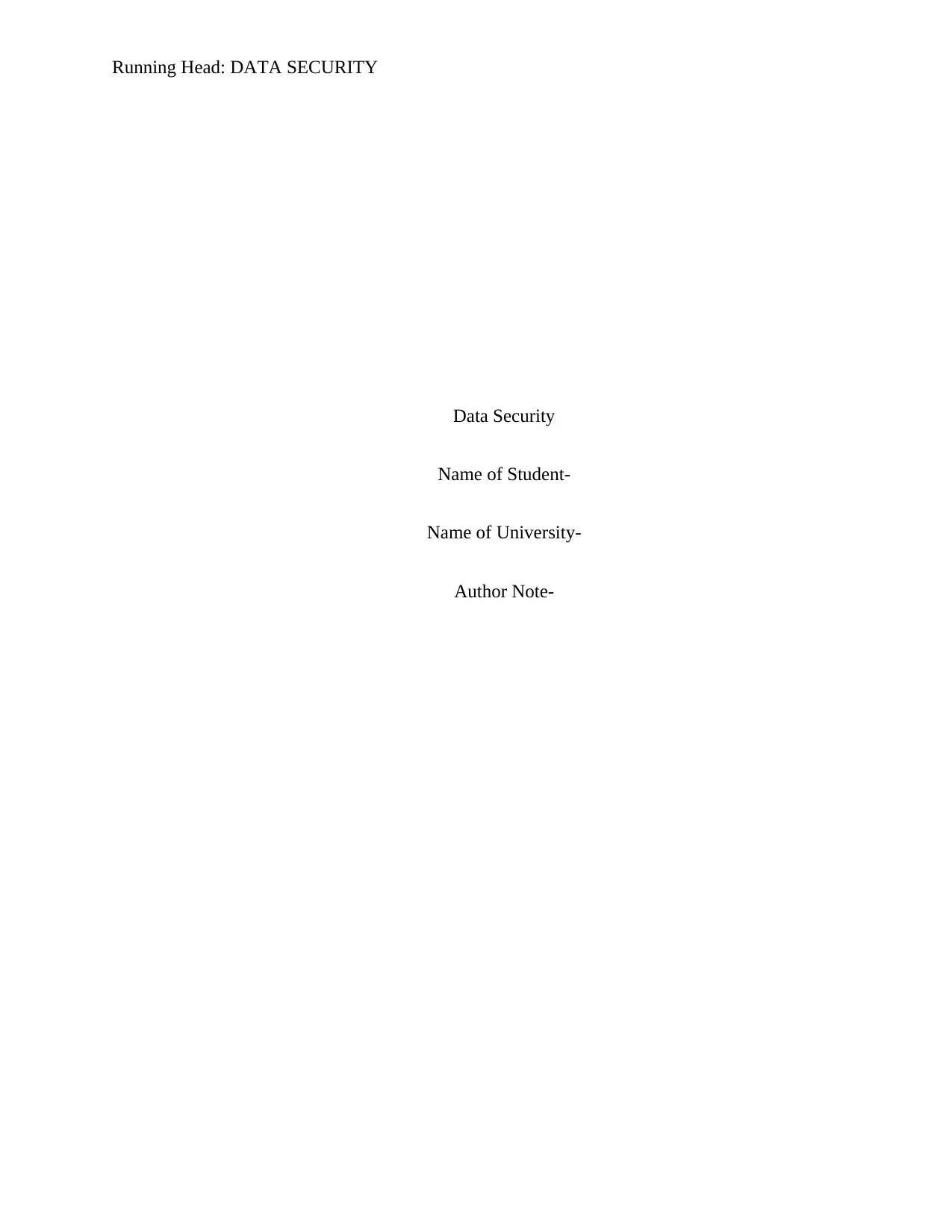
Running Head: DATA SECURITY
Data Security
Name of Student-
Name of University-
Author Note-
Data Security
Name of Student-
Name of University-
Author Note-
Paraphrase This Document
Need a fresh take? Get an instant paraphrase of this document with our AI Paraphraser
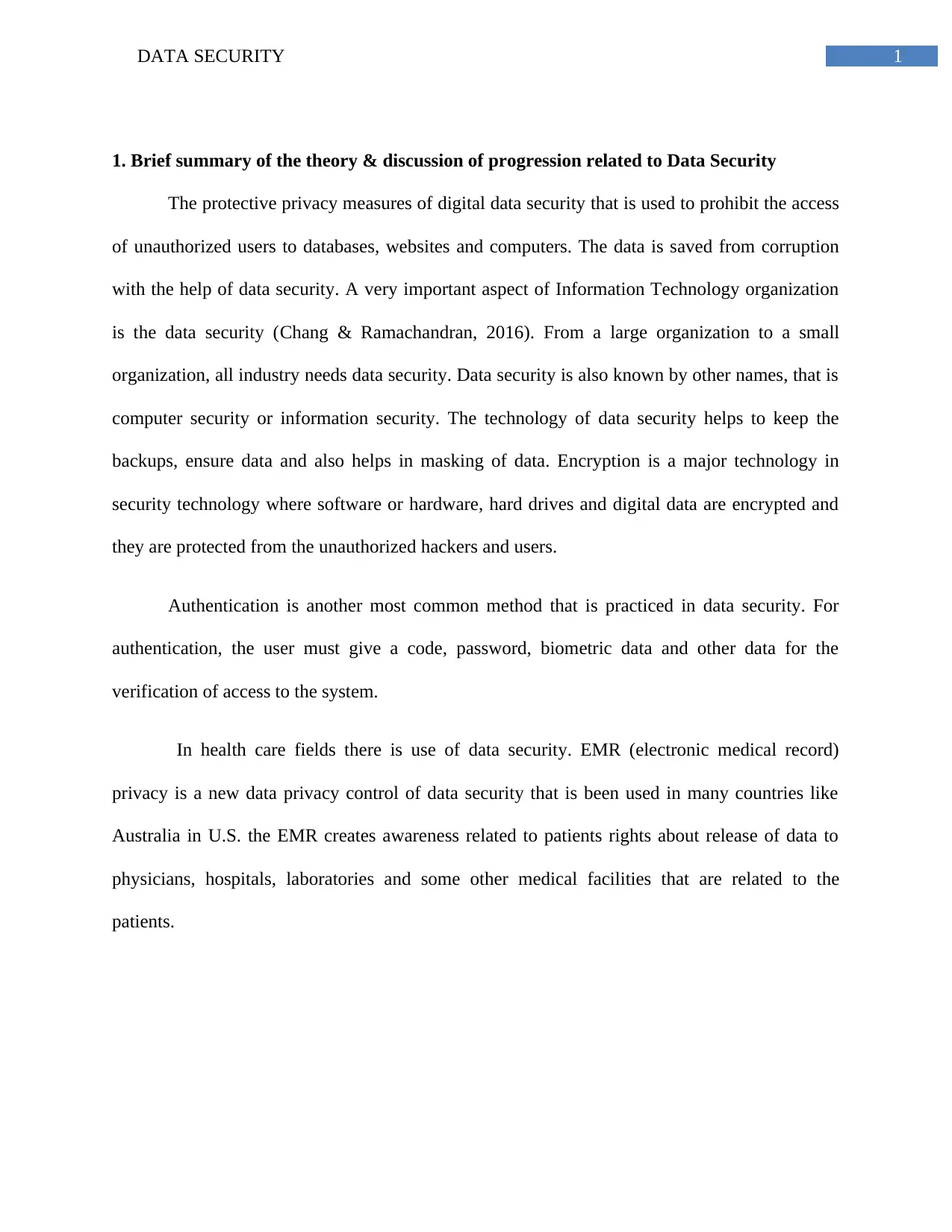
1DATA SECURITY
1. Brief summary of the theory & discussion of progression related to Data Security
The protective privacy measures of digital data security that is used to prohibit the access
of unauthorized users to databases, websites and computers. The data is saved from corruption
with the help of data security. A very important aspect of Information Technology organization
is the data security (Chang & Ramachandran, 2016). From a large organization to a small
organization, all industry needs data security. Data security is also known by other names, that is
computer security or information security. The technology of data security helps to keep the
backups, ensure data and also helps in masking of data. Encryption is a major technology in
security technology where software or hardware, hard drives and digital data are encrypted and
they are protected from the unauthorized hackers and users.
Authentication is another most common method that is practiced in data security. For
authentication, the user must give a code, password, biometric data and other data for the
verification of access to the system.
In health care fields there is use of data security. EMR (electronic medical record)
privacy is a new data privacy control of data security that is been used in many countries like
Australia in U.S. the EMR creates awareness related to patients rights about release of data to
physicians, hospitals, laboratories and some other medical facilities that are related to the
patients.
1. Brief summary of the theory & discussion of progression related to Data Security
The protective privacy measures of digital data security that is used to prohibit the access
of unauthorized users to databases, websites and computers. The data is saved from corruption
with the help of data security. A very important aspect of Information Technology organization
is the data security (Chang & Ramachandran, 2016). From a large organization to a small
organization, all industry needs data security. Data security is also known by other names, that is
computer security or information security. The technology of data security helps to keep the
backups, ensure data and also helps in masking of data. Encryption is a major technology in
security technology where software or hardware, hard drives and digital data are encrypted and
they are protected from the unauthorized hackers and users.
Authentication is another most common method that is practiced in data security. For
authentication, the user must give a code, password, biometric data and other data for the
verification of access to the system.
In health care fields there is use of data security. EMR (electronic medical record)
privacy is a new data privacy control of data security that is been used in many countries like
Australia in U.S. the EMR creates awareness related to patients rights about release of data to
physicians, hospitals, laboratories and some other medical facilities that are related to the
patients.
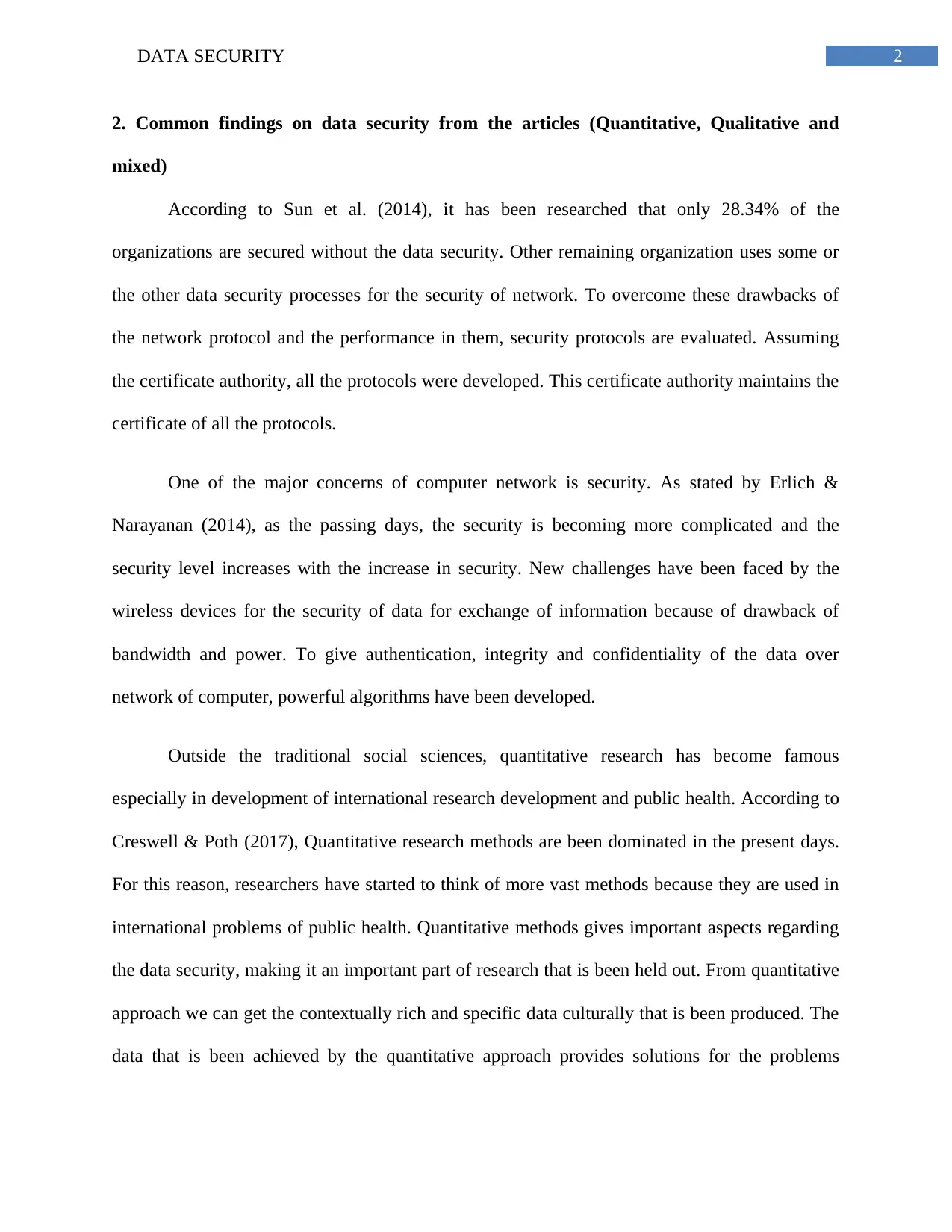
2DATA SECURITY
2. Common findings on data security from the articles (Quantitative, Qualitative and
mixed)
According to Sun et al. (2014), it has been researched that only 28.34% of the
organizations are secured without the data security. Other remaining organization uses some or
the other data security processes for the security of network. To overcome these drawbacks of
the network protocol and the performance in them, security protocols are evaluated. Assuming
the certificate authority, all the protocols were developed. This certificate authority maintains the
certificate of all the protocols.
One of the major concerns of computer network is security. As stated by Erlich &
Narayanan (2014), as the passing days, the security is becoming more complicated and the
security level increases with the increase in security. New challenges have been faced by the
wireless devices for the security of data for exchange of information because of drawback of
bandwidth and power. To give authentication, integrity and confidentiality of the data over
network of computer, powerful algorithms have been developed.
Outside the traditional social sciences, quantitative research has become famous
especially in development of international research development and public health. According to
Creswell & Poth (2017), Quantitative research methods are been dominated in the present days.
For this reason, researchers have started to think of more vast methods because they are used in
international problems of public health. Quantitative methods gives important aspects regarding
the data security, making it an important part of research that is been held out. From quantitative
approach we can get the contextually rich and specific data culturally that is been produced. The
data that is been achieved by the quantitative approach provides solutions for the problems
2. Common findings on data security from the articles (Quantitative, Qualitative and
mixed)
According to Sun et al. (2014), it has been researched that only 28.34% of the
organizations are secured without the data security. Other remaining organization uses some or
the other data security processes for the security of network. To overcome these drawbacks of
the network protocol and the performance in them, security protocols are evaluated. Assuming
the certificate authority, all the protocols were developed. This certificate authority maintains the
certificate of all the protocols.
One of the major concerns of computer network is security. As stated by Erlich &
Narayanan (2014), as the passing days, the security is becoming more complicated and the
security level increases with the increase in security. New challenges have been faced by the
wireless devices for the security of data for exchange of information because of drawback of
bandwidth and power. To give authentication, integrity and confidentiality of the data over
network of computer, powerful algorithms have been developed.
Outside the traditional social sciences, quantitative research has become famous
especially in development of international research development and public health. According to
Creswell & Poth (2017), Quantitative research methods are been dominated in the present days.
For this reason, researchers have started to think of more vast methods because they are used in
international problems of public health. Quantitative methods gives important aspects regarding
the data security, making it an important part of research that is been held out. From quantitative
approach we can get the contextually rich and specific data culturally that is been produced. The
data that is been achieved by the quantitative approach provides solutions for the problems
⊘ This is a preview!⊘
Do you want full access?
Subscribe today to unlock all pages.

Trusted by 1+ million students worldwide

3DATA SECURITY
regarding public health to develop countries, medical doctors, humanitarian organizations and
many more.
Using both the approaches together, the limitation of one approach is compensated by the
limitation of the other approach (Yang et al., 2013). When used together, the data are balanced
by strength of other. This helps to integrate many ways of knowing the data. Most of the
evaluations are done by collecting the quantitative and the qualitative approaches.
3. Different findings on data security (Quantitative, Qualitative and mixed)
According to Taha et al. (2013), any findings are still evaluated that calculate the
quantitative findings on the study of data security. The data in quantitative research can be
analyzed in numbers in a quantitative research. Quantitative uses the use of data that are
numerical which describes the security of the data. The researches that are achieved from the
quantitative approach more readily analyzed and are interpreted.
The approach of quantitative method is more time taking, stressful and harder. It is an
empirical research where data is not in form of numbers (Cao et al., 2014). The quantitative
analysis of data security shows graphs; pictures and other pictorial format where the need of data
security is needed in many of the organization can be seen. People who is serious about their
research and want to prepare the research for commitment uses this quantitative approach of data
security.
Most of the researchers use the mixed approach analysis to do the research of data
security (Zhang, Chang & Yap, 014). In mixed approach, the finding that is got from the
qualitative approach is cross checked against the quantitative approach to get the exact
information regarding the data security.
regarding public health to develop countries, medical doctors, humanitarian organizations and
many more.
Using both the approaches together, the limitation of one approach is compensated by the
limitation of the other approach (Yang et al., 2013). When used together, the data are balanced
by strength of other. This helps to integrate many ways of knowing the data. Most of the
evaluations are done by collecting the quantitative and the qualitative approaches.
3. Different findings on data security (Quantitative, Qualitative and mixed)
According to Taha et al. (2013), any findings are still evaluated that calculate the
quantitative findings on the study of data security. The data in quantitative research can be
analyzed in numbers in a quantitative research. Quantitative uses the use of data that are
numerical which describes the security of the data. The researches that are achieved from the
quantitative approach more readily analyzed and are interpreted.
The approach of quantitative method is more time taking, stressful and harder. It is an
empirical research where data is not in form of numbers (Cao et al., 2014). The quantitative
analysis of data security shows graphs; pictures and other pictorial format where the need of data
security is needed in many of the organization can be seen. People who is serious about their
research and want to prepare the research for commitment uses this quantitative approach of data
security.
Most of the researchers use the mixed approach analysis to do the research of data
security (Zhang, Chang & Yap, 014). In mixed approach, the finding that is got from the
qualitative approach is cross checked against the quantitative approach to get the exact
information regarding the data security.
Paraphrase This Document
Need a fresh take? Get an instant paraphrase of this document with our AI Paraphraser
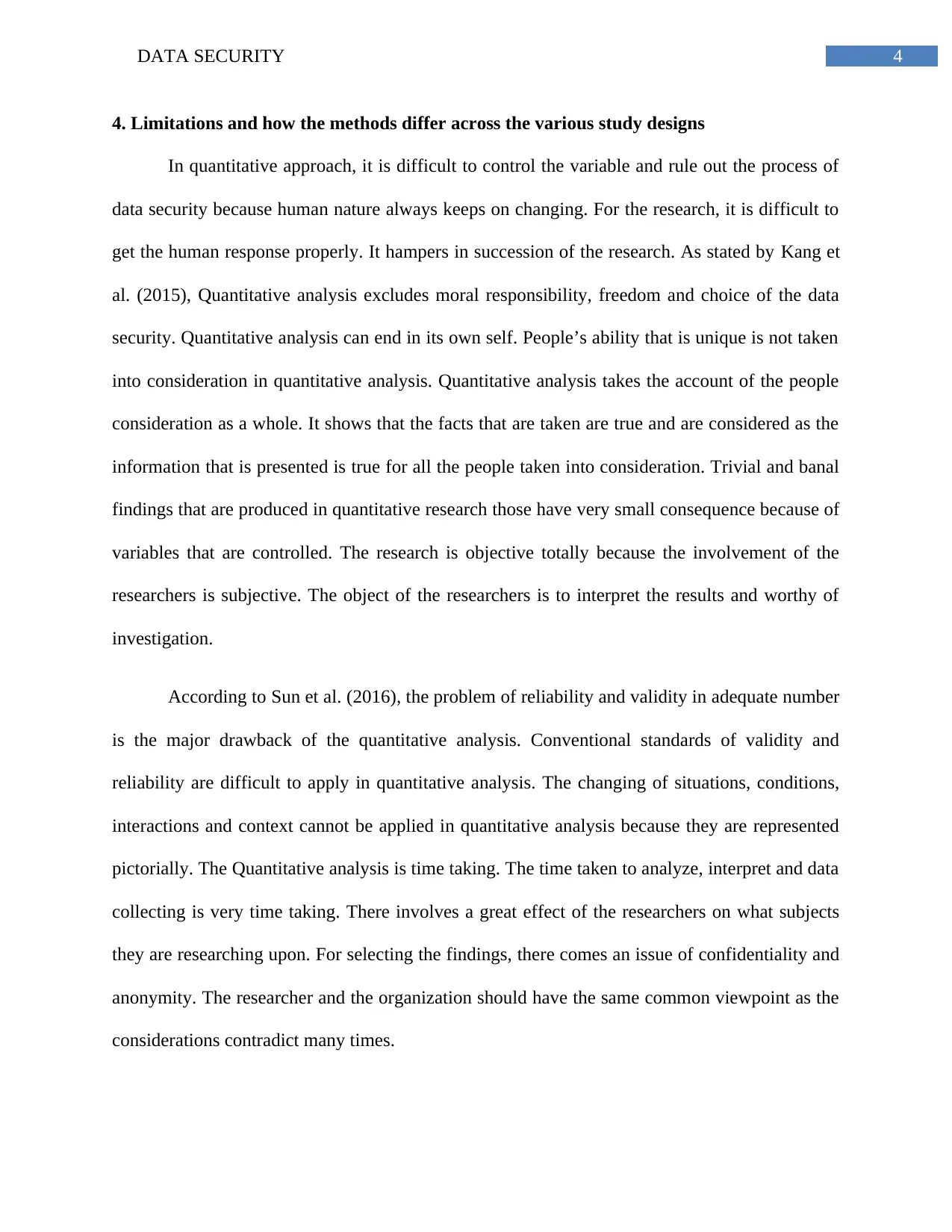
4DATA SECURITY
4. Limitations and how the methods differ across the various study designs
In quantitative approach, it is difficult to control the variable and rule out the process of
data security because human nature always keeps on changing. For the research, it is difficult to
get the human response properly. It hampers in succession of the research. As stated by Kang et
al. (2015), Quantitative analysis excludes moral responsibility, freedom and choice of the data
security. Quantitative analysis can end in its own self. People’s ability that is unique is not taken
into consideration in quantitative analysis. Quantitative analysis takes the account of the people
consideration as a whole. It shows that the facts that are taken are true and are considered as the
information that is presented is true for all the people taken into consideration. Trivial and banal
findings that are produced in quantitative research those have very small consequence because of
variables that are controlled. The research is objective totally because the involvement of the
researchers is subjective. The object of the researchers is to interpret the results and worthy of
investigation.
According to Sun et al. (2016), the problem of reliability and validity in adequate number
is the major drawback of the quantitative analysis. Conventional standards of validity and
reliability are difficult to apply in quantitative analysis. The changing of situations, conditions,
interactions and context cannot be applied in quantitative analysis because they are represented
pictorially. The Quantitative analysis is time taking. The time taken to analyze, interpret and data
collecting is very time taking. There involves a great effect of the researchers on what subjects
they are researching upon. For selecting the findings, there comes an issue of confidentiality and
anonymity. The researcher and the organization should have the same common viewpoint as the
considerations contradict many times.
4. Limitations and how the methods differ across the various study designs
In quantitative approach, it is difficult to control the variable and rule out the process of
data security because human nature always keeps on changing. For the research, it is difficult to
get the human response properly. It hampers in succession of the research. As stated by Kang et
al. (2015), Quantitative analysis excludes moral responsibility, freedom and choice of the data
security. Quantitative analysis can end in its own self. People’s ability that is unique is not taken
into consideration in quantitative analysis. Quantitative analysis takes the account of the people
consideration as a whole. It shows that the facts that are taken are true and are considered as the
information that is presented is true for all the people taken into consideration. Trivial and banal
findings that are produced in quantitative research those have very small consequence because of
variables that are controlled. The research is objective totally because the involvement of the
researchers is subjective. The object of the researchers is to interpret the results and worthy of
investigation.
According to Sun et al. (2016), the problem of reliability and validity in adequate number
is the major drawback of the quantitative analysis. Conventional standards of validity and
reliability are difficult to apply in quantitative analysis. The changing of situations, conditions,
interactions and context cannot be applied in quantitative analysis because they are represented
pictorially. The Quantitative analysis is time taking. The time taken to analyze, interpret and data
collecting is very time taking. There involves a great effect of the researchers on what subjects
they are researching upon. For selecting the findings, there comes an issue of confidentiality and
anonymity. The researcher and the organization should have the same common viewpoint as the
considerations contradict many times.
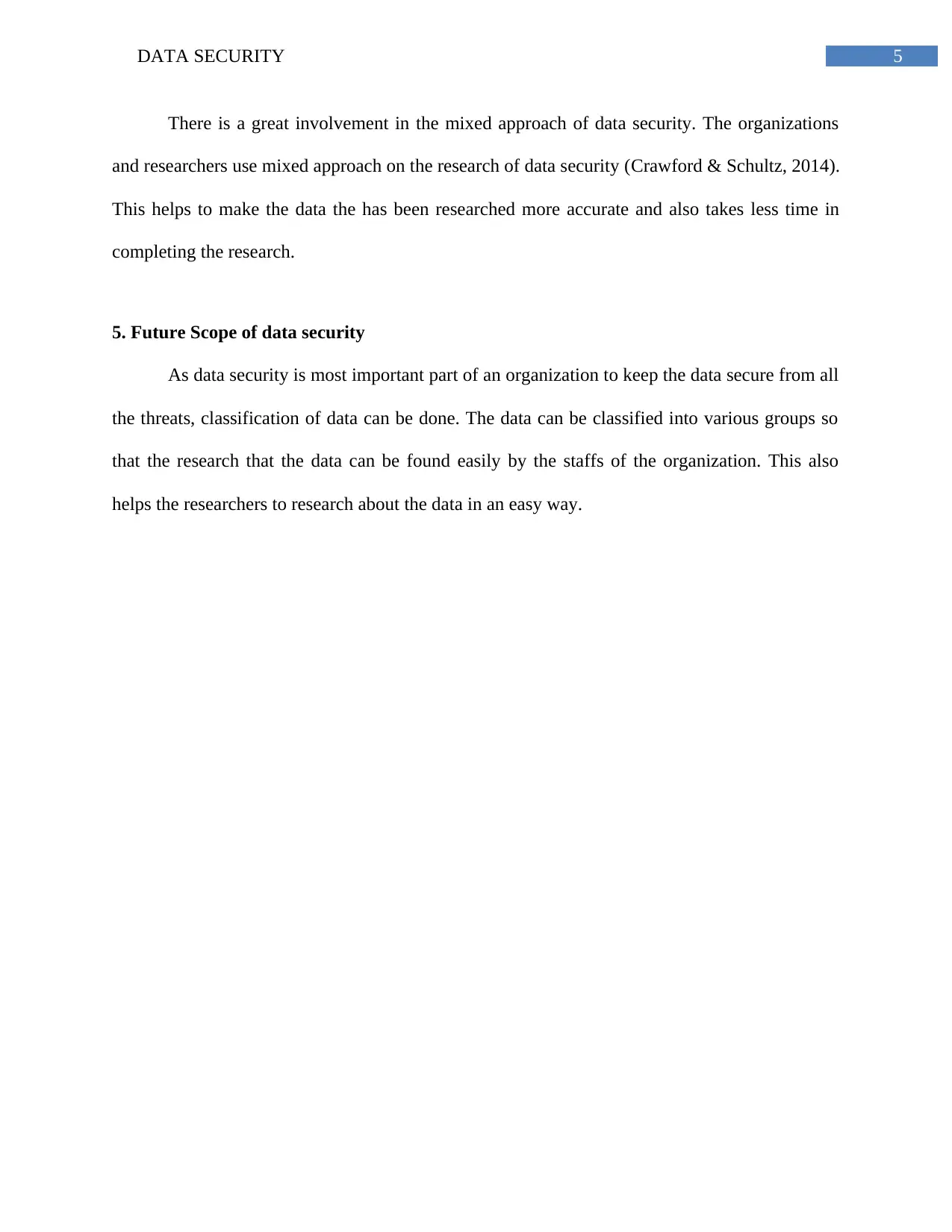
5DATA SECURITY
There is a great involvement in the mixed approach of data security. The organizations
and researchers use mixed approach on the research of data security (Crawford & Schultz, 2014).
This helps to make the data the has been researched more accurate and also takes less time in
completing the research.
5. Future Scope of data security
As data security is most important part of an organization to keep the data secure from all
the threats, classification of data can be done. The data can be classified into various groups so
that the research that the data can be found easily by the staffs of the organization. This also
helps the researchers to research about the data in an easy way.
There is a great involvement in the mixed approach of data security. The organizations
and researchers use mixed approach on the research of data security (Crawford & Schultz, 2014).
This helps to make the data the has been researched more accurate and also takes less time in
completing the research.
5. Future Scope of data security
As data security is most important part of an organization to keep the data secure from all
the threats, classification of data can be done. The data can be classified into various groups so
that the research that the data can be found easily by the staffs of the organization. This also
helps the researchers to research about the data in an easy way.
⊘ This is a preview!⊘
Do you want full access?
Subscribe today to unlock all pages.

Trusted by 1+ million students worldwide

6DATA SECURITY
References
Cao, N., Wang, C., Li, M., Ren, K., & Lou, W. (2014). Privacy-preserving multi-keyword
ranked search over encrypted cloud data. IEEE Transactions on parallel and distributed
systems, 25(1), 222-233.
Chang, V., & Ramachandran, M. (2016). Towards achieving data security with the cloud
computing adoption framework. IEEE Transactions on Services Computing, 9(1), 138-
151.
Creswell, J. W., & Poth, C. N. (2017). Qualitative inquiry and research design: Choosing among
five approaches. Sage publications.
Erlich, Y., & Narayanan, A. (2014). Routes for breaching and protecting genetic privacy. Nature
reviews. Genetics, 15(6), 409.
Kang, R., Dabbish, L., Fruchter, N., & Kiesler, S. (2015, July). my data just goes everywhere:”
user mental models of the internet and implications for privacy and security.
In Symposium on Usable Privacy and Security (SOUPS)(pp. 39-52). Berkeley, CA:
USENIX Association.
Sun, Y., Zhang, J., Xiong, Y., & Zhu, G. (2014). Data security and privacy in cloud
computing. International Journal of Distributed Sensor Networks, 10(7), 190903.
Taha, A., Trapero, R., Luna, J., & Suri, N. (2014, September). Ahp-based quantitative approach
for assessing and comparing cloud security. In Trust, Security and Privacy in Computing
References
Cao, N., Wang, C., Li, M., Ren, K., & Lou, W. (2014). Privacy-preserving multi-keyword
ranked search over encrypted cloud data. IEEE Transactions on parallel and distributed
systems, 25(1), 222-233.
Chang, V., & Ramachandran, M. (2016). Towards achieving data security with the cloud
computing adoption framework. IEEE Transactions on Services Computing, 9(1), 138-
151.
Creswell, J. W., & Poth, C. N. (2017). Qualitative inquiry and research design: Choosing among
five approaches. Sage publications.
Erlich, Y., & Narayanan, A. (2014). Routes for breaching and protecting genetic privacy. Nature
reviews. Genetics, 15(6), 409.
Kang, R., Dabbish, L., Fruchter, N., & Kiesler, S. (2015, July). my data just goes everywhere:”
user mental models of the internet and implications for privacy and security.
In Symposium on Usable Privacy and Security (SOUPS)(pp. 39-52). Berkeley, CA:
USENIX Association.
Sun, Y., Zhang, J., Xiong, Y., & Zhu, G. (2014). Data security and privacy in cloud
computing. International Journal of Distributed Sensor Networks, 10(7), 190903.
Taha, A., Trapero, R., Luna, J., & Suri, N. (2014, September). Ahp-based quantitative approach
for assessing and comparing cloud security. In Trust, Security and Privacy in Computing
Paraphrase This Document
Need a fresh take? Get an instant paraphrase of this document with our AI Paraphraser
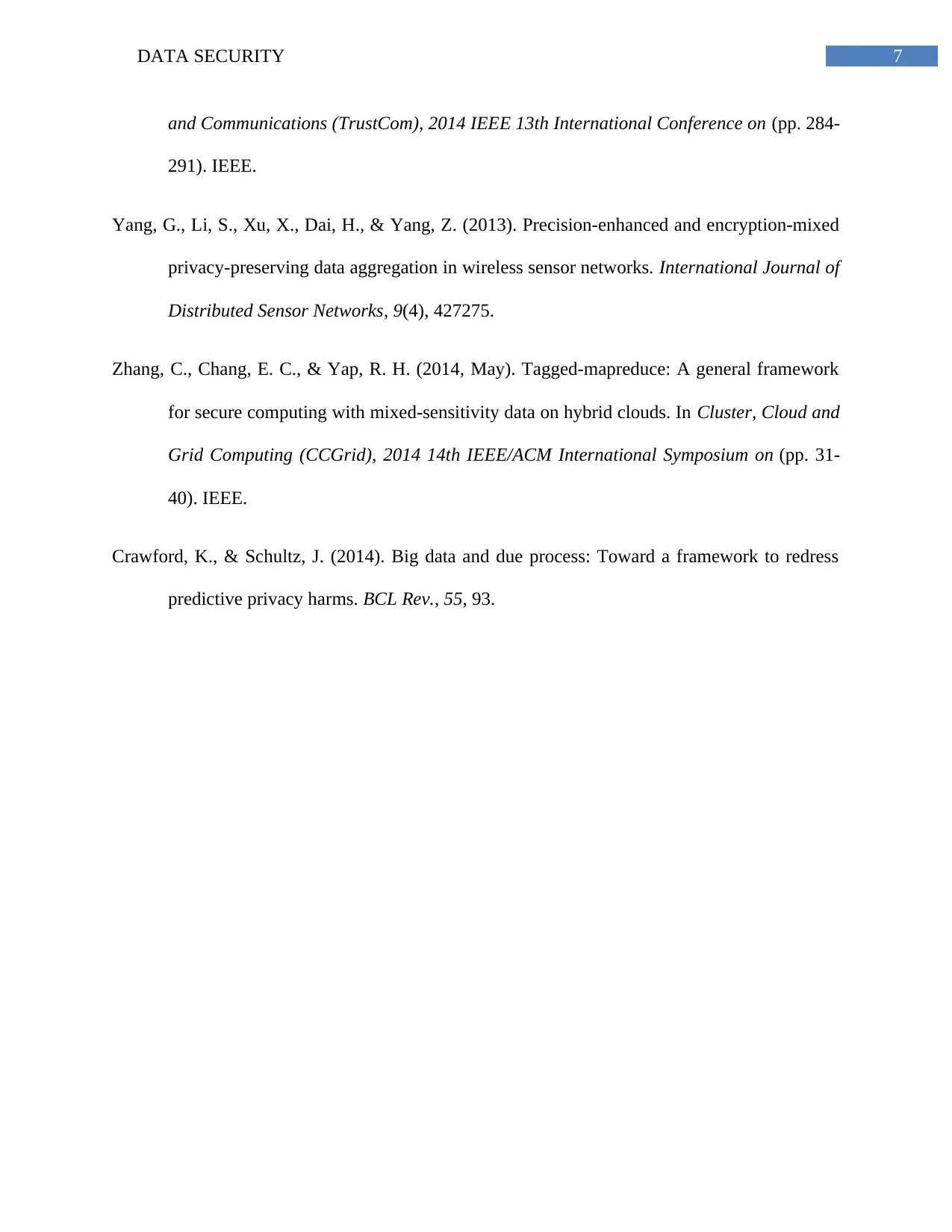
7DATA SECURITY
and Communications (TrustCom), 2014 IEEE 13th International Conference on (pp. 284-
291). IEEE.
Yang, G., Li, S., Xu, X., Dai, H., & Yang, Z. (2013). Precision-enhanced and encryption-mixed
privacy-preserving data aggregation in wireless sensor networks. International Journal of
Distributed Sensor Networks, 9(4), 427275.
Zhang, C., Chang, E. C., & Yap, R. H. (2014, May). Tagged-mapreduce: A general framework
for secure computing with mixed-sensitivity data on hybrid clouds. In Cluster, Cloud and
Grid Computing (CCGrid), 2014 14th IEEE/ACM International Symposium on (pp. 31-
40). IEEE.
Crawford, K., & Schultz, J. (2014). Big data and due process: Toward a framework to redress
predictive privacy harms. BCL Rev., 55, 93.
and Communications (TrustCom), 2014 IEEE 13th International Conference on (pp. 284-
291). IEEE.
Yang, G., Li, S., Xu, X., Dai, H., & Yang, Z. (2013). Precision-enhanced and encryption-mixed
privacy-preserving data aggregation in wireless sensor networks. International Journal of
Distributed Sensor Networks, 9(4), 427275.
Zhang, C., Chang, E. C., & Yap, R. H. (2014, May). Tagged-mapreduce: A general framework
for secure computing with mixed-sensitivity data on hybrid clouds. In Cluster, Cloud and
Grid Computing (CCGrid), 2014 14th IEEE/ACM International Symposium on (pp. 31-
40). IEEE.
Crawford, K., & Schultz, J. (2014). Big data and due process: Toward a framework to redress
predictive privacy harms. BCL Rev., 55, 93.
1 out of 8
Related Documents
Your All-in-One AI-Powered Toolkit for Academic Success.
+13062052269
info@desklib.com
Available 24*7 on WhatsApp / Email
![[object Object]](/_next/static/media/star-bottom.7253800d.svg)
Unlock your academic potential
Copyright © 2020–2025 A2Z Services. All Rights Reserved. Developed and managed by ZUCOL.





